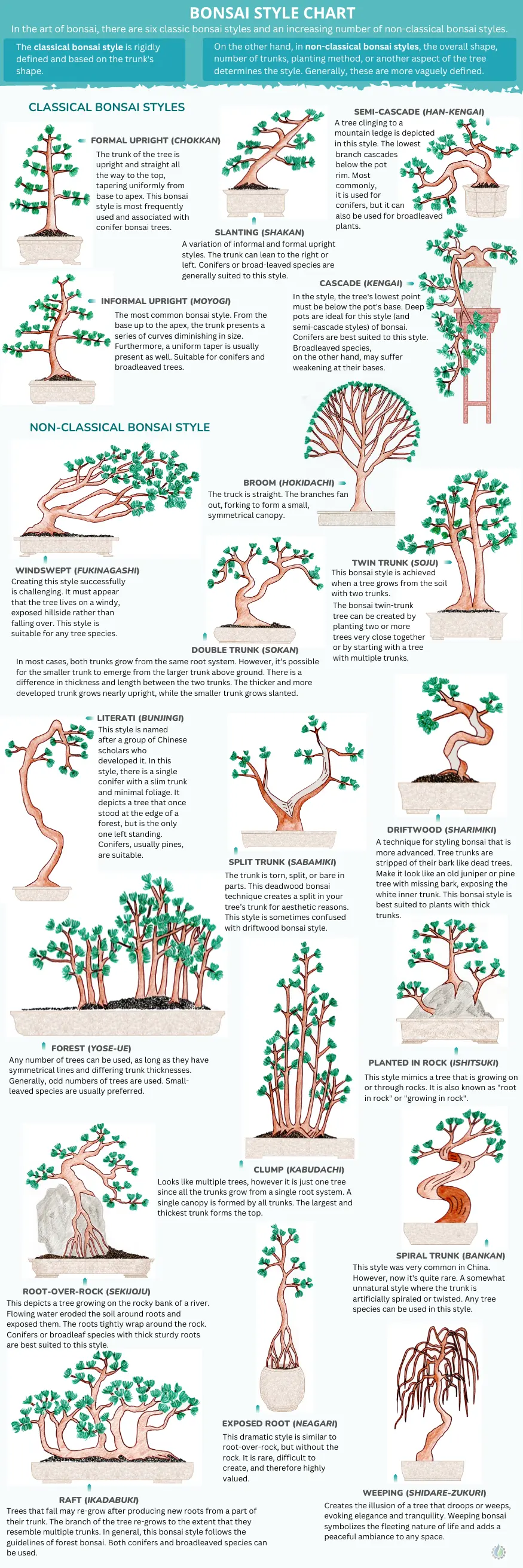In nature, trees grow in a wide variety of shapes and sizes. Trees can grow either straight upright or slightly tilted. It is even possible for them to grow in pairs or groups. Furthermore trees growing in plain fields will have a different shape from trees growing on the side of mountains. A tree’s shape is also affected by its environment and stress factors.
In bonsai, the artist mimics a tree’s natural shape. There are certain rules of bonsai one should adhere to. However, the artist can apply some of his own creative vision to create an attractive bonsai with his own unique signature.
Through skillful wiring and pruning, bonsai trees (especially Japanese bonsai specimens) are heavily stylized and refined. Japanese bonsai artists have classified them into over a dozen clearly defined styles.
No matter what type of bonsai tree you are growing, you must shape it in a defined bonsai style. Bonsai styles can broadly be classified into 2 categories: Classic bonsai styles (aka basic bonsai styles or traditional bonsai styles) and Non-Classic bonsai styles.
There are 5 classic bonsai styles: Formal upright (chokkan), Informal upright (moyogi), Slanting (shakan), Semi-cascade (han-kengai), Cascade (kengai).
The rest of the bonsai styles can be classified under non-classical bonsai styles.
Please read the type of bonsai styles to see a detailed guide to various types of bonsai styles.
Please refer to the bonsai style chart below. Download the bonsai style chart (PNG image version). OR download the pdf format Bonsai styles PDF.

What are the basic styles in bonsai?
There are five basic styles of bonsai. These basic styles are also sometimes called as classic bonsai style or traditional bonsai style. These five basic styles derive their names from the tree’s growth angle from a container. Furthermore, these styles are rigidly defined as opposed to non-classic bonsai styles.
- Formal upright, or chokkan: The trunk of the tree is vertical and straight.
- Informal upright, or moyogi: The tree grows vertically however the trunk line has slight curves and bends.
- Slanting, or shakan: While the tree leans to one side, its top remains above the pot.
- Semi-cascade, or han-kengai: The tree leans to one side and the top of the tree hangs below the rim of the pot.
- Cascade, or kengai: Leaning over the edge of the container, the tree cascades downward, often dropping below the pot’s bottom edge.
What is the easiest bonsai style?
Formal upright bonsai style aka chokkan (Japanese) is the easiest bonsai style. This style depicts a single tree standing alone in its most basic form.
In fact, bonsai beginners begin learning bonsai structure by creating a formal upright design. Having mastered the basics of bonsai design with a formal upright, bonsai growers can design other styles more easily.
What is the most common style bonsai?
Informal upright bonsai style aka moyogi (Japanese) is one of the most common bonsai style. This bonsai style represents a tree in nature that has been affected by the environment, with a distorted trunk line and sagging branches.
Is bonsai a tree or style?
Bonsai is not a specific tree species. Bonsai refers to both a tree and a style. The word “bonsai” itself translates to “planted in a container” in Japanese, and it encompasses the art of growing and styling miniature trees in containers.
Bonsai trees are carefully cultivated and trained to mimic the shape and proportions of full-sized trees found in nature.
The term “bonsai” can also refer to the specific styles and techniques used to shape and present these miniature trees, such as the formal upright style, cascading style, or windswept style etc. So, essentially, bonsai is both the tree itself and the artistic approach used to create and maintain its unique form.
What is the best bonsai shape?
Determining the “best” bonsai shape is subjective and largely depends on personal preference, aesthetic goals, and the characteristics of the type of bonsai tree.
Some of the most popular bonsai shape are informal upright (most common) followed by formal upright (easiest) bonsai style. However, there are also other types of styles like double trunks, brooms, cascades, or slanting that are quite common and make for very attractive bonsai trees.
To conclude, the best bonsai shape is one that resonates with you and evokes a sense of harmony and natural beauty. It is a shape that harmonizes with the tree’s inherent characteristics and tells a captivating story. Whether you prefer the elegance of a formal upright or the dynamic movement of a windswept design, the key is to create a bonsai shape that captures your imagination and brings you joy every time you gaze upon it.


